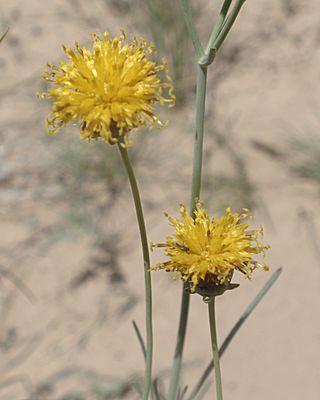
Coreopsis lanceolata, commonly known as lanceleaf coreopsis, lanceleaf tickseed, lance-leaved coreopsis, or sand coreopsis, is a North American species of tickseed in the family Asteraceae.

Coreopsis tinctoria, commonly known as plains coreopsis, garden tickseed, golden tickseed, or calliopsis, is an annual forb. The species is common in Canada, northeast Mexico, and most of the United States, especially the Great Plains and Southern States. It is introduced into many countries in Europe and Asia.

Coreopsis auriculata, the lobed tickseed or mouse-ear tickseed, is a North American plant species of the family Asteraceae. It is native to the southeastern and east-central United States, from Louisiana east to the Florida Panhandle and as far north as Kentucky, Maryland, and West Virginia.

Coreopsis nuecensis, the crown tickseed, is an annual, herbaceous, flowering plant in the Asteraceae family. It is native to Texas, and probably Tamaulipas. There are reports of isolated populations in Michigan and Florida, both probably escapes from cultivation.

Coreopsis pubescens, commonly called the star tickseed is a perennial, herbaceous, flowering plant in the Asteraceae family. It is found primarily in the central and southeastern United States. There are also reports of disjunct populations in New England and in northern Indiana, probably escapees from cultivation.

Coreopsis stillmanii is a species of flowering plant in the family Asteraceae known by the common name Stillman's tickseed. It is endemic to California, where it grows in the Central Valley and most of the adjacent coastal and inland mountain ranges in California chaparral and woodlands habitats. It is found east of San Francisco Bay and on the eastern side of the Central Valley.

Bidens vulgata is a species of flowering plant in the family Asteraceae known by the common names big devils beggarticks and tall beggarticks. It is native to eastern and central North America from Nova Scotia to northern Georgia and as far west as the Rocky Mountains. It is an introduced species on the West Coast of North America as well as parts of Europe.

Thelesperma, commonly known as greenthreads, is a genus of annual or perennial herbs and subshrubs found in the Americas. Members of this genus are closely related to some species of Coreopsis and Bidens. The genus is considered to be within the family Asteraceae.

Symphyotrichum pilosum is a perennial, herbaceous, flowering plant in the Asteraceae family native to central and eastern North America. It is commonly called hairy white oldfield aster, frost aster, white heath aster, heath aster, hairy aster, common old field aster, old field aster, awl aster, nailrod, and steelweed. There are two varieties: Symphyotrichumpilosum var.pilosum, known by the common names previously listed, and Symphyotrichumpilosum var.pringlei, known as Pringle's aster. Both varieties are conservationally secure globally and in most provinces and states where they are native.

Thelesperma megapotamicum is a perennial, herbaceous, flowering plant in the Asteraceae family native to sections of the Americas. It is known by the common names Hopi tea greenthread, rayless greenthread, Navajo tea, cota, and greenthread.

Bidens aristosa, known by many common names such as bearded beggarticks, western tickseed, showy tickseed, long-bracted beggarticks, tickseed beggarticks, swamp marigold, and Yankee lice, is an herbaceous, annual plant in the Asteraceae family. It is native to the central United States, but has been introduced to the eastern United States, Canada, France, Great Britain, and India. It grows in marshes, meadows, pine forests and disturbed sites.

Cosmos parviflorus, commonly known as the southwestern cosmos, is an annual, herbaceous, flowering plant in the Asteraceae family. It is native to parts of the Southwestern United States and most of Mexico and appears to be introduced in portions of the Northeastern United States.

Bidens bidentoides, commonly called swamp beggar's-ticks and delmarva beggarticks, is an annual, herbaceous, flowering plant in the Asteraceae family. It is native to the northeastern and east-central parts of the United States, the coastal plain of the States of Maryland, Delaware, Pennsylvania, and New Jersey plus the region around the Hudson River estuary in New York.

Bidens bigelovii, commonly called Bigelow's beggarticks, is an annual herbaceous flowering plant in the Asteraceae family. It is native to the southwestern and south-central United States and as far south as Oaxaca, Mexico.
Bidens heterosperma, commonly known as the Rocky Mountain beggarticks, is an annual or perennial, herbaceous, flowering plant in the family Asteraceae, tribe Coreopsideae. It is native to northwestern and north-central Mexico, and portions of the southwestern United States.

Xyris montana, the northern yelloweyed grass, is a perennial herbaceous flowering plant in the family Xyridaceae. It grows in eastern and central Canada and in the northeastern and north-central United States.
Coreopsis bakeri, commonly called Baker's tickseed, is a perennial, herbaceous, flowering plant in the Asteraceae family. It is endemic to two counties in northeastern Florida. It is closely related to Coreopsis lanceolata.

Symphyotrichum concolor is a species of flowering plant in the family Asteraceae with the common name eastern silvery aster. It is a perennial, herbaceous plant that may reach 30 to 80 centimeters in height. Leaves are a grayish-green and have a silky look and feel. The flowers have 8–12 rose-purple, rarely white, ray florets, and pink then purple disk florets. It is native to the Atlantic coastal plain and Piedmont areas of the eastern United States, as well as the Bahamas.

Symphyotrichum undulatum is a species of flowering plant in the family Asteraceae native to eastern North America. Its common name is wavyleaf aster, and it is a perennial, herbaceous plant that flowers August through October and may reach heights between 30 and 160 centimeters.

Thelesperma simplicifolium, commonly known as the slender greenthread, is a perennial, herbaceous, flowering plant in the Asteraceae family. It is found from Texas and Mexico in openings in oak or juniper woodlands or on desert scrub.



















